For the past 12 months Alan Lauder, former grazier and author of the book “Carbon Grazing – The Missing Link”, has written a series of weekly blogs for the Soils for Life website, discussing carbon flows in a different way for graziers to look at the landscape and understand how it functions. Published here is the final blog post in his series which ties together his years of research on carbon flows and why they are central to the sustainable beef debate.
THE most over-used and misused word in the English language is “sustainable”.
Everybody uses it, but often there is little agreement on what it means. The term is like a magnet to nebulous feel good words.
Beef production being sustainable has two aspects: producers have to remain profitable and the environment has to remain healthy as a result of beef production, including water quality.
To achieve both aspects of sustainability, the “resilience” of the paddock has to be maintained. The only way paddock resilience can be maintained in both the short-term and long-term, is to ensure that sufficient carbon keeps flowing through the paddock. The natural world can’t “function” without carbon flows.
For me, “Sustainable Beef” is producing beef at a profit while maintaining the “integrity” of the production system. The former Norwegian Prime Minister Gro Harlem Brundtland was thinking in a similar way when he said, “Sustainable development is development that meets the needs of the present without compromising the ability of future generations to meet their own needs”.
The difference between resilience and sustainability is that one is a state/condition and the other is an outcome. The dictionary says sustainability means “keep from failing”.
Most processes focus on carbon stocks and measurement when defining sustainable beef. To ensure there is no confusion over terminology, below is carbon stocks and carbon flows explained.
Talking about carbon stocks is to look at an outcome. Talking about carbon flows is to understand what caused the outcome, i.e. a process.
When beef production is not sustainable, everybody starts talking about all the negative outcomes from human stress to environmental problems. This is really talking about the symptoms, not the cause. Trying to solve each symptom separately is applying reductionist science instead of looking at the big picture and trying to identify the common denominator.
Why carbon flows?
All debates should start with the basics. Get the basics wrong and nothing else is going to fall into place the way they should.
Carbon is the organiser as it flows through the paddock above and below ground. The movement of carbon activates so many processes that occur in the paddock. Energy, nutrients and water all follow the path of carbon.
Carbon is the main building block of all life, be it grass, cattle or soil life. Cattle are 18% carbon and grass is 45% carbon. Flowing carbon is also responsible for keeping all life above and below ground functioning, because it carries the energy all life needs. When the level of carbon flowing through a paddock drops, then the level of life in the paddock drops.
Higher carbon flows result in more cattle to sell and more soil life to keep the soil well structured and fertile. When carbon flows start to drop, this is the first stage of soil degradation.
The landscape is interactive – self organised – however we “disorganise” it when we mismanage carbon.
The two components of paddock resilience
Paddock resilience is a combination of plant resilience and soil resilience and both rely on carbon flows.
Maintaining plant resilience relies on good animal management. Poor animal management, that reduces plant growth after rain, reduces the flow of carbon into plants and the paddock.
To remain resilient, plants need adequate carbon flowing into them to maintain energy reserves and build extensive root systems for sourcing water and nutrients. Roots are also important for water infiltration into the soil, they act as wicks to take water down through the soil profile. The water travels down beside the roots. The wick effect is especially important with harder soils. Roots are 45% carbon.
The perennial grass plant above is what a plant lacking resilience looks like. It is struggling to come out of dormancy after good rain because it is short of stored energy. Energy reserves in plants are short-term carbon brought in by carbon flows. In perennial grasses they are stored in the roots and also in the crown. These reserves are the energy source prior to green leaves collecting energy. This plant is generating no carbon flows to feed soil life or cattle.
Maintaining soil resilience also relies on animal management. Think of the soil as a construction site. Soil life is responsible for keeping the soil well structured and fertile. If animal management reduces the ability of plants to supply carbon compounds to soil life, then their population drops.
Carbon flowing into plants is the true source of soil organic matter. Soil organic matter is about 58% carbon (short-term carbon). Organic matter changes the bulk density of soil, which adds to water storage capacity. Apart from being a store of nutrients, organic matter is the raw material for humus, which is long-term soil carbon. Humus is the undigested portions of organic matter.
Because humus is highly charged, it will aggregate many soil particles into stable aggregates. This leads to better soil structure and it is the resultant pores that hold extra water containing the soluble nutrients like nitrate nitrogen. Humus also has a higher water holding capacity than clay because it has a smaller particle size. Humus changes the pH of the soil and so buffers against any toxic elements present.
With poor animal management, plant resilience fails first, then soil resilience declines. Poorly managed plants do not generate enough carbon flows to keep the soil healthy. This highlights that your animal management affects the soil, by affecting plants first.
What paddock resilience and lack of it looks like
For those seeking tangible evidence of when resilience exists, it is the ability of a paddock to generate carbon flows from rain, i.e. how well the pasture responds to rain. Perhaps the best test of resilience is the ability of paddocks to respond to isolated small falls of rain during a dry period.
The next photo was taken by Patrick Francis and I thank him for capturing such a powerful image.
Water infiltration is the first requirement for producing carbon flows.
The right hand side of the fence is a grazing paddock, not a farming paddock and is what an unsustainable beef operation looks like. Look at the surface water right up to the fence and nothing on the other side. The pooled water is caused by more than just poor soil structure, there is also a lack of roots in the paddock to help water enter the soil. Unsustainable beef is nutrients flowing onto the Great Barrier Reef. Moreover, the lost nutrients and water could have been driving higher beef production for economic sustainability.
Paddock resilience is the ability to generate carbon flows
The two pictures above show the productive capacity of each side of the fence at a later date, i.e. the ability to produce carbon flows. The top photo is the left hand side of the fence and the bottom one the right hand side of the fence. The resilience of each side of the fence is very different. Stating the obvious, resilience, sustainability and water use efficiency all rely on ongoing carbon flows.
This series of photos explains what is behind disappointment when a paddock does not respond to rain very well. The photos also highlight that current carbon flows rely on past carbon flows. Just as money makes money, so carbon makes carbon. This feedback loop is central to understanding/defining sustainable beef.
Natural systems (paddocks) have evolved to remain resilient (sustainable) and can withstand extreme events such as drought or heavy rain, but we reduce their “defences” when our management reduces the level of carbon flowing through them.
The “Carbon Grazing” principle relates to managing carbon flows
If the first priority for achieving sustainable beef is keeping enough carbon flowing through the paddock, above and below ground, then management has to be focused on when the bulk of the carbon arrives.
Nature has designed the system so that water activates the flow of carbon into the landscape via photosynthesis. The bulk of the carbon arrives from the atmosphere in the short period following rain. Think of plants as the entry point of carbon into the paddock. After entering plants, carbon then flows everywhere else in the paddock, including through cattle.
Nature does not have a predictable pattern. Stated simply, we must allow nature to transfer carbon from the atmosphere to the landscape according to its time frame. This is why pasture rest is TIMING, not TIME.
Basing resting decisions on a certain period of TIME is no guarantee that carbon will come into the paddock because there is no guarantee that it will rain.
The “Carbon Grazing” principle has as its basis, that effective pasture rest is achieved when enough carbon has flowed above and below ground to all the areas it needs to.
Carbon Grazing is resting pastures for 4 – 6 weeks after rain. This time was arrived at after talking to a cross section of scientists and producers. It is important to not get caught up on the exact time between four and six weeks, as temperature influences plant growth. Also, the length of rest required, depends on the resilience of the paddock, as resilience is at the centre of pasture response. One producer I spoke to, with really healthy pastures, is of the opinion that he can achieve full recovery after about four weeks.
Scientists I met in South Africa carried out research which suggested that with average pastures, removing animals for 3 – 8 weeks after rain, increased pasture production by 50 – 80%. Given pasture is about 45% carbon when dried, this gives an indication of the increased carbon flows, including below ground.
When people say that they can’t afford to rest pastures, it begs the question, can you afford not to.
Carbon Grazing is a principle and just that, not a new land management system. It underpins all successful land management systems. In a sense, the principle is an action plan.
Carbon Grazing relates to the first phase of carbon flows, which is the introduction phase, i.e. when carbon moves from the atmosphere to the paddock via photosynthesis during plant growth. This is when the level of carbon available to flow through the paddock above and below ground, including through cattle, is set.
Carbon Grazing is strategic (tactical) rest after rain, and is based on the premise that nature does not have a predictable pattern.
Carbon Grazing is short-term removal of animals from pastures after rain.
The practical aspect of seeing pasture rest as TIMING, instead of TIME, is that you only need to find an alternative home for animals for a short period of time.
Some of the “increased” ground cover that results from a resting exercise (Carbon Grazing) can be utilised as somewhere to put animals next time it rains, i.e. the capacity for resting resides in existing pastures. An earlier column discussed different techniques for resting pastures after rain without selling animals.
Producers have no control over how much rain arrives but they do have control over the level of carbon flows generated by what rain does arrive. Rain is obviously a major driver of production but it is not the final determinant – it is the level of flowing carbon that determines the level of rural production and landscape health.
The box above is saying that animals should start harvesting what resides above ground after adequate carbon has flowed to all parts of the landscape, including below ground. The wording is saying don’t eat the conduit prematurely. This approach will ensure future animal production and ongoing resilience of the production base. It will also ensure better environmental outcomes.
TIME relates to consumption
It is important not to confuse management of flows with consumption of existing stocks (pasture).
Resting for set periods of time when it is not raining is a consumption issue (maintaining ground cover) and should not be confused with strategic / tactical rest after rain. The exception is when a regeneration event has occurred and freshly germinated perennial seedlings need to be protected to allow them to establish.
How much ground cover is consumed is important, but it is the second decision a producer makes, not the first. What sets the level of ground cover in the first place, is the amount of carbon a particular form of management allows to enter the paddock after rain.
Provided it is not excessive, grazing is beneficial for carbon flows as it removes rank pasture that can inhibit pasture growth next time it rains.
Carbon Grazing gives confidence to the broader community
Producers who implement the Carbon Grazing procedure at least once a year are in the position to represent to the broader community that they are responsible custodians of the land.
The carbon flows concept is the package of knowledge that provides an understanding of why there has to be adequate carbon flowing through the paddock to ensure beef is sustainable. The Carbon Grazing principle is part of this knowledge package.
The term “Carbon Grazing” was coined in 2001 and registered the same year. It was coined for the purpose of drawing attention to the importance of maximising carbon inflows for both profit and environmental outcomes.
Better management of carbon flows reduces methane per kg of production
The methane debate is one of subtleties, with the true issue being the production of methane per kg of production. Differences between production systems become clearer when the outputs are expressed this way.
The major strategy for reducing methane production is the same as the key driver for profitability in grazing: reducing the number of grazing days per kilo of product, and this relies on improving the digestibility of the diet.
Good management of carbon flows is so important for increasing the digestibility of the pasture.
Resting paddocks for a short period after rain increases the percentage of leaves to stems. Leaves are more digestible than stems, i.e. have a lower carbon:nitrogen ratio.
Resting pastures after rain increases pasture resilience, which in turn results in pastures being able to respond better to rain and so being green for a higher percentage of the year. Green pasture is more digestible than dry pasture, again a lower carbon:nitrogen ratio.
Thinking visually, we need to speed up carbon as it flows through the rumen of cattle to reduce methane and increase profits. More nitrogen (protein) attached to the carbon speeds it up.
The level of methane produced is another example of the general principle that the greenhouse outcomes of agriculture are a reflection of economic efficiency.
Just thinking carbon stocks can give a false sense of environmental security
Perhaps because of climate change policy, we have become too preoccupied with carbon stocks and measuring carbon and not paying enough attention to carbon flows.
Photo: Patrick Francis
The photo above shows carbon stock per unit area may be increasing via expanding tree growth, but carbon flows have been ignored creating negative issues for cattle production, cattle health, soil health and the owner’s business. Just talking about carbon stocks is far too narrow when discussing sustainable beef.
Highlighting that paddocks are different, when defining sustainable beef, is taking a reductionist science approach
It is often stated that because of the broad range of ecosystems in which beef is produced, a “one size-fits-all” global standard is unrealistic.
Circumstances change but the general principles of landscape function don’t.
In Nov 2008 I was invited as the guest speaker to open the Queensland NRM Groups Collective Grazing Symposium in Cairns. The person working for the Collective who invited me, said people in the Groups around the state kept talking about how different they were and this was not consistent with the over-riding body calling itself a Collective. My brief was to highlight how much they had in common. My talk concentrated on all the carbon processes that were common to all regions in the state.
There is one aspect of sustainable beef production that is common to every country, every farm and every paddock, and that is the proper management of “carbon flows”.
Patrick Francis on gaining the trust of consumers
This is an extract from a paper that Patrick Francis prepared for a 2014 workshop held by QLD DAFF. It was held to consider the need for a separate carbon module in extension programs. Patrick was the editor for 32 years of the Australian Farm Journal and its predecessor FARM Magazine.
Consumers may not understand how carbon flows impact livestock productivity and health, and improvements to ecosystem services, but they do know they are important and want to be associated with them when purchasing red meat. Incorporating carbon flows knowledge as suggested by Alan Lauder into education programs provides them with additional credibility needed to meet consumer expectations for ethical production.
Red meat marketers are keen to promote ethical characteristics for brands but in reality there is little credible basis at industry level on which to justify claims made, figure 3. The carbon flows concept if widely understood and applied by farmers will underpin many of the ethical claims already being made about beef.
Incorporation of carbon flows functions within grazing best management practice training programs has post farm gate beef marketing implications as it provides a credible basis on which to make red meat brand claims which an increasing percentage of consumers are looking for in respect of livestock health and welfare and environmental management irrespective of challenging climatic conditions.” Photos: Patrick Francis
Conclusion
The only time you can build paddock resilience is during the short period after rain.
Sustainable Beef really means sustainable management.
Leaving the management of carbon flows out of defining sustainable beef is like an engineer leaving gravity out of calculations.
With carbon, once you understand the flows, you see the dynamics of the whole landscape and how it functions.
It is often said that healthy soils are the foundation of healthy ranches, but taking one step further back, it is actually carbon flows that are the foundation of healthy ranches. This is because it is carbon flows that keep plants healthy which in turn keep soil healthy. It is carbon compounds that underpin the health/resilience of both plants and the soil and these carbon compounds will not exist without carbon flows.
A resilient paddock is one that has the ability to generate enough carbon flows from rain to keep itself functional and productive.
There are some subtle realities that underpin the Carbon Grazing principle. Because there is no pattern to when rain arrives, in other words when carbon arrives, the message is that pasture rest is TIMING and not TIME. Basing resting decisions on a certain period of TIME is no guarantee that carbon will arrive.
Two paddocks can have equal long-term soil carbon stocks, but it is the one that has the most carbon flowing through it, that will have the highest level of production.
For the clear thinkers – when it comes to carbon, if you can’t measure a change in the stocks, then all the carbon has to be in the flow.
Carbon Grazing is about attending to the most fundamental thing a grazier/rancher has to get right, and that is to maximise carbon flows from any rain that arrives. If you do not attend to the basics, then nothing else will fall into place the way it should.
Good management of carbon flows is the basis of sustainable beef production and catchment protection.
This is the last column in the “Why carbon flows?” series and I want to acknowledge that they would have been of a lower standard without the support of Madeleine Florin who scrutinised every column before they went out – thankyou Madeleine. I also want to thank Soils For Life for posting the columns on Facebook and Twitter.
- All of Alan Lauder’s weekly “Why Carbon Flows” weekly blogs now reside on the Soil for Life website, and can be viewed here

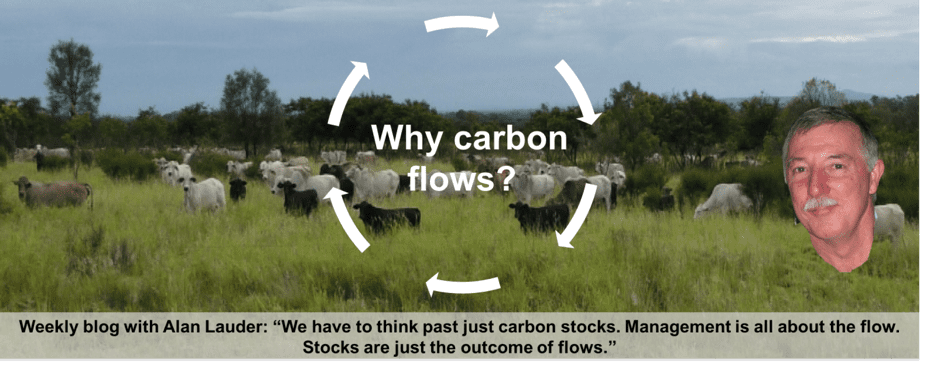
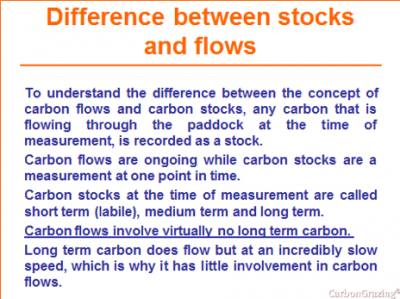
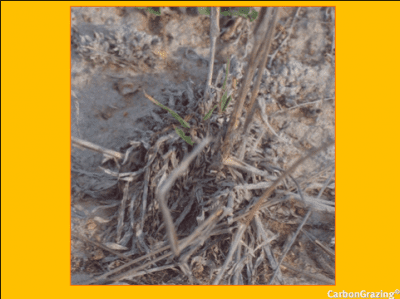
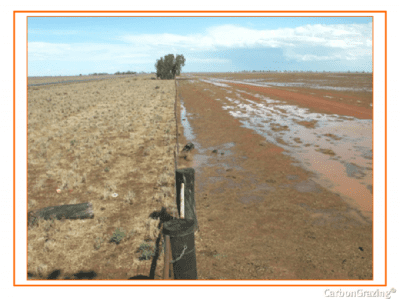
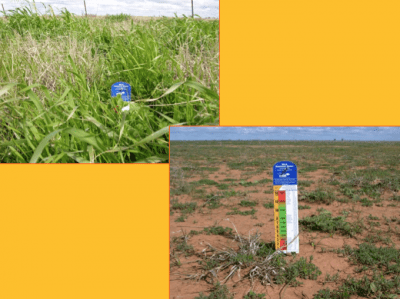
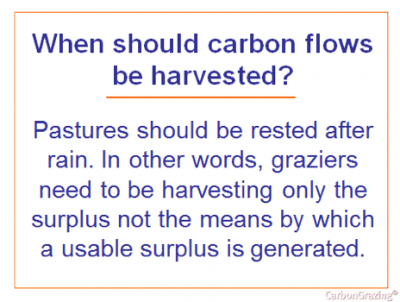
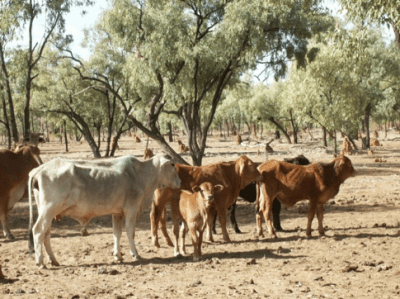
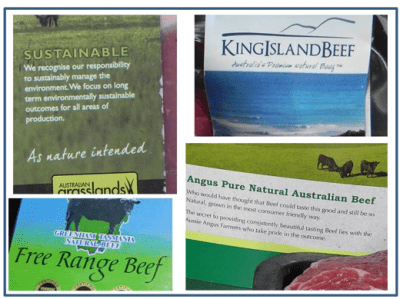
Marsupial flow is a critical part of the holistic issue as correctly raised, But the marsupials appear to have truly rejoiced in their reproduction frenzy as a result of the development of a reticulated watering system for cattle and sheep? There seem to have been natural controls to marsupials before 1787? Do the gurus in Canberra appreciate these dynamics?
This is a thought provoking article, based on many basic research results. It has to fit within the concepts of rural ecological manipulation and positive farm economics. As rightly stated by some commentators, not all regions are the same, but within that situation all farmers/graziers need to be profitable to survive.
From a philosophical aspect I have found that most graziers consider that pasture is grown to feed livestock, but a very wise grazier I met in Mongolia considers that livestock should be used to harvest the pasture and not to exploit it. To undertake this consideration would benefit the carbon cycling. Considering that this may be true, provides a different manner in assessing the “European model” of grazing that we are generally taught in Australia.
A good read but I find it incomplete and another step to understanding problems.
I find it incomplete as it seems to be taking everywhere as being the same. Removing grazing pressure after rain while good in theory may not be suitable for vast areas of the country. In some areas the grass will easily outgrow the grazing pressure during the rain season. In other areas it won’t as the grass is slower to get going and grow. In some areas cutting up large paddocks into cells will create more problems with erosion from roads and fencing and costs blowing out significantly.
But as an aside why are we supposed to prove our sustainability, and why not the cities? Who here thinks say Sydney is sustainable? If we removed fossil fuel use from Sydney how long would the city survive? A week if that? Hardly sustainable. I believe segments of the Australian beef industry are not sustainable, for example the lotfeeding sector, as they rely on fossil fuels so much, but the extensive pasture systems mostly are, even if grazing numbers had to be reduced. At the end of the day the Australian beef industry while being maligned, is being done so as those bagging it want a scapegoat so no one looks at the bigger problems that would be deeply unpopular to fix.
Thank you Beef Central for getting this information out.
It is unfortunate that the Head Office of our Qld Dept of Agriculture and Fisheries (DAF) can’t get their head around this way of thinking.
Stopping the Marsupial flow with exclusion fences is a pre-requisite to ensuring carbon flows happen across a lot of drought prone Australia.
after beneficial rain. Maximizing rainfall infiltration and minimizing run off is also critical and necessarily impacts on dam catchments. That is why our underground water supplies are vital in under-pining sustainable grazing systems and must be protected from the short term , unsustainable mining and CSG sectors
Alan’s series of articles have enlightened so many of us to think about carbon in the first instance, and then once carbon becomes central to our thinking and focus – we can then begin to consider the complications that certain types of livestock and grazing management have created in Australia and globally – and what we need to do about it. Alan has caused some of us to ask ourselves “Well, I wonder how the vegetation looked here in 1787 before those blokes landed in Botony Bay?” The likes of Raymond Dasmann, Richard Teague and Charles Massy have certainly given us a bit more to think about, so that the solution is actually no longer a mystery – it is simply a paradigm shift. Great work Alan – thanks for your inimitable style, overall grasp and above all, your generous spirit of sharing.
Having read Alan’s book and lent it multiple times I remain indebted to Alan for the unequalled insight into how “things” work, or rather how they might work if we grasp the mettle.
I have tested some of Alans simpler proclamations in my own small way and found them to be precise and accurate.
Alan’s book could be the handbook for all graziers and deserves to be so.
Likewise the 36 one page “Why Carbon Flows” columns. These could be progressive handouts in all Ag colleges and even primary school (Gr 11 & 12)agriculture classes.
What a tremendous insight Alan has into this topic and how simply and elegantly explained. It’s little wonder that Alan’s book “Carbon Grazing” is used at Colorado State University, a university rightly lauded for its Agriculture courses and where Professor Temple Grandin (famed for her insights into the management of beef) teaches.
Great information and and much to learn.
Thanks for sharing.